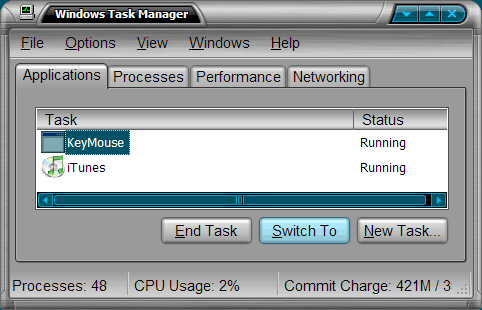This free Windows utility remaps the right "Alt" key so it becomes the right mouse button instead. Useful for people with only one mouse button...

The source code shows how to intercept low-level keyboard events and how to synthesize low-level mouse events. If you know how to program, you can easily adapt it to disable other keys.
This program installs a "low level keyboard hook". Whenever the right alt key (VK_RMENU) goes down, we generate a right-mouse-down event. When the right alt key goes up, we generate a right-mouse-up event. To respond to other keypresses instead, look in MSDN or winuser.h
Generation of events is by SendInput(..), a Windows NT/2k/XP function.
The keyboard hook is installed with SetWindowsHookEx(WH_KEYBOARD_LL,...), which is also specific to NT/2k/XP. This hook has the nice feature that it can "gobble up" keyboard events, so they're not seen by the rest of the system. Note: WH_KEYBOARD_LL always sets a global hook and so works for all applications. But unlike most global hooks (which have to reside in a DLL), the WH_KEYBOARD_LL can instead reside in an EXE. What Windows does is, whenever it receives a keypress, it switches to the context of the EXE that contained the hook, then invokes the hook function, then restores context back to what it was before.
The main routine sets the hook, then creates an invisible top-level window, and when the top-level window gets closed (by ending it in the TaskManager), we unhook the hook. Note: it might seem nicer not to have any window at all, and just to enter an infinite loop. But (1) with a window we can exit more gracefully (and we can also choose to appear in the Process List of the taskmanager). And (2) keyboard hooks fail to work when there's just a tight infinite loop of Sleep(). It just wasn't working. Then when I created the window and did a message-loop it magically started working. My guess is that the context-switching might internally use the message-loop mechanism, or something like that.
#define _WIN32_WINNT 0x0500 #include <windows.h> LRESULT CALLBACK LowLevelKeyboardProc(int nCode, WPARAM wParam, LPARAM lParam) { PKBDLLHOOKSTRUCT p = (PKBDLLHOOKSTRUCT)lParam; // static bool keydown=false; if (nCode==HC_ACTION && p->vkCode==VK_RMENU && (wParam==WM_KEYDOWN || wParam==WM_SYSKEYDOWN)) { keydown=true; INPUT ip; ZeroMemory(&ip,sizeof(ip)); ip.type=INPUT_MOUSE; ip.mi.dwFlags=MOUSEEVENTF_RIGHTDOWN; SendInput(1,&ip,sizeof(ip)); return 1; } if (nCode==HC_ACTION && p->vkCode==VK_RMENU && (wParam==WM_KEYUP || wParam==WM_SYSKEYUP) && keydown) { INPUT ip; ZeroMemory(&ip,sizeof(ip)); ip.type=INPUT_MOUSE; ip.mi.dwFlags=MOUSEEVENTF_RIGHTUP; SendInput(1,&ip,sizeof(ip)); return 1; } return CallNextHookEx(0,nCode,wParam,lParam); } LRESULT CALLBACK WndProc(HWND hwnd, UINT msg, WPARAM wParam, LPARAM lParam) { if (msg==WM_DESTROY) PostQuitMessage(0); return DefWindowProc(hwnd, msg, wParam, lParam); } int WINAPI WinMain(HINSTANCE hInstance,HINSTANCE,LPSTR,int) { HHOOK hook = SetWindowsHookEx(WH_KEYBOARD_LL, LowLevelKeyboardProc, hInstance, 0); // WNDCLASSEX wcex; ZeroMemory(&wcex,sizeof(wcex)); wcex.cbSize=sizeof(WNDCLASSEX); wcex.lpfnWndProc=(WNDPROC)WndProc; wcex.hInstance=hInstance; wcex.lpszClassName=L"KeyMouseClass"; RegisterClassEx(&wcex); CreateWindowEx(WS_EX_NOACTIVATE,L"KeyMouseClass", L"KeyMouse",WS_POPUP|WS_VISIBLE,0,0,0,0,0,0,hInstance,0); MSG msg; while (GetMessage(&msg, NULL, 0, 0)) {TranslateMessage(&msg); DispatchMessage(&msg);} // MessageBeep(0); UnhookWindowsHookEx(hook); return (int)msg.wParam; }